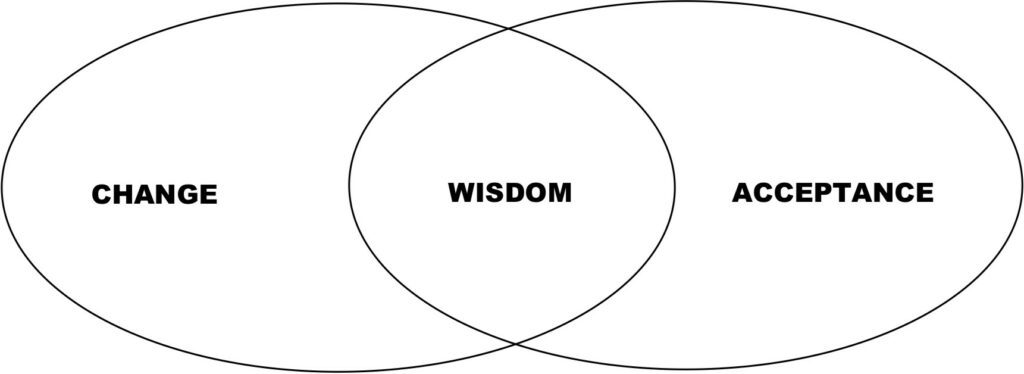“God grant me the serenity to accept the things I cannot change; courage to change the things I can; and wisdom to know the difference.”
–The Serenity Prayer of Reinhold Niebuhr
Many of us are familiar with the Serenity Prayer. It deals with the dialectic of acceptance vs. change. The key to this dialectic is the knowledge that the things we cannot change are things we must accept. Mindfulness comes from having the wisdom to know the difference. We can illustrate this concept this way:

One of the skills we develop in the practice of mindfulness is the skill of acceptance. Acceptance allows us to experience emotions and thoughts without feeling obligated to react to them. This is done by noting the emotion or thought, and then letting go of the thought and feeling processes that the emotion generates.
Mindful awareness teaches us the art of acceptance. Emotional reactions to our circumstances are natural, but that doesn’t mean that we have to respond to these emotions. The mindful skill of acceptance teaches us that we can experience these emotions without engaging in cycles of behavior, thought or feeling that lead us to negative consequences. Acceptance teaches us that we are not our thoughts, and that we are not our emotions. At any time we can choose which thoughts and emotions we wish to respond to, and which to let go of.
From this perspective there is no such thing as a “wrong” feeling or a “bad” thought. Thoughts and feelings are just processes of the brain. What may be problematic is how we choose to respond to those thoughts or feelings. Sometimes we can choose to do nothing and simply be with the feeling. When problems arise, they most often come when we try to do something to “fix” feelings or thoughts we don’t want to experience.
“Never underestimate your power to change yourself; never overestimate your power to change others.”
–H. Jackson Brown, Jr.
Some things in life that cause us stress, anxiety and depression are things we can change. Others are things we cannot change, but must learn to accept. As Niebuhr reminds us, true wisdom lies in knowing the difference between the two. In being mode, we come to recognize the fact that true happiness can only come from within. There’s good news and bad news with this realization. The bad news is that nobody can change your life circumstances but you. The good news is that nobody can change your life circumstances but you.
Mindful acceptance includes, among other things, the idea that you can only change yourself. If your problems involve other people, then you can only accept that they are who they are. You cannot change anyone but yourself.
The art of mindful acceptance can best be described as the art of letting go. Once you have done everything in your power to solve a problem, you have done all you can, so at that point worry and stress is counterproductive. Note that letting go of the stress and anxiety doesn’t necessarily mean letting go of the problem itself. For example, suppose you have a car payment coming up, and you don’t have the money to pay it. This would naturally cause you anxiety. If, after brainstorming for solutions, you find that you still don’t have the money to pay the car payment, then at that point you’ve done all you can do. So at that point, you let go of the anxiety associated with the problem. That doesn’t mean that you let go of car payments altogether. You’ll make the payment when you can. In this instance, “letting go” just means that you won’t worry about not being able to make the payment. The energy you might have used worrying about the situation could be put to better use in trying to come up with solutions.
Let’s try another example, this one a bit tougher. Imagine you’re in a relationship. You feel that your partner doesn’t spend enough time with you. You offer suggestions on activities you can do together, only to be met with a blank stare or excuses about why your partner doesn’t have the time to participate in an activity with you. Once you’ve done everything you can do to persuade your partner to spend more time with you, if you still aren’t getting the results you want, it’s time to practice letting go. This doesn’t necessarily mean that you let go of your partner. It just means that you let go of the anxiety associated with the problem. Once you let go of that anxiety, you may find that your partner will actually want to spend more time with you, because you are less stressed-out. But even if this is not the case, you’ve let go of the stress associated with a potentially emotionally distant partner.
Mindful acceptance is looking at the thoughts and feelings that cause you anxiety, worry, or stress. As you examine these thoughts, ask yourself which of these thoughts concern things you have the power to change. Make a conscious decision to focus your energy only on those things in your life that you have the power to change. If you focus on those things that you cannot change, you are not using your energy to change the things that you can.
Decide right now that you will not feed your negative thoughts by giving in to them. Realize that it is natural to have negative thoughts, but having those thoughts does not mean that they have to control your life. Learn trust your own inner wisdom. While negative thoughts may come, you do not have to let them rule your life.

Another key to mindful acceptance is to understand that anxiety has a useful purpose. It is nature’s way of letting us know that there is something wrong. Your anxiety protects you from harm, but sometimes it may do its job too well. Ask your anxiety if it is trying to protect you from something that you cannot change. Picture yourself thanking your anxiety for protecting you, and say to your anxiety, “I am now using my own inner wisdom to make positive choices in my life.”
Mindful acceptance teaches us that each mistake is an opportunity for growth. Each mistake contains a lesson. If you never made a mistake, you would never have an opportunity to learn and grow. With mindful acceptance, you learn to accept your mistakes as signs that you are becoming a stronger and wiser individual.
Acceptance and Commitment Therapy (ACT) was developed as a method of introducing the techniques of mindfulness into psychotherapy. ACT is based on Relational Frame Theory (RFT), which is a theoretical framework developed by Steven Hayes of the University of Nevada. RFT is a way of looking at how language influences behavior, and how behavior influences languages. A corollary to RTF is that a large part of our reality, our world of experience, is constructed by the language we use, and the ways in which we relate that language to the real world. This would mean that a lot of the things that cause us anxiety, stress, depression, and other unpleasant thoughts and feelings, are the result of how we use language to interpret our world.
While Cognitive Behavior Therapy (CBT) concentrates on teaching people how to better control their thoughts and feelings, ACT focuses on teaching people how to acknowledge and accept their own internal dialog without feeling overwhelmed by those thoughts and feelings. It teaches the student/practitioner to be in the moment with those feelings and thoughts, without having to identify with them. This applies to unwanted thoughts and feelings as well. By seeing these as processes of the mind, acceptance increases.
One of the goals of ACT is to get in touch with what Buddhists call true self. True self is that internal observer who is watching these processes without becoming engaged in them. True self helps in the process of externalization. Externalization is the process of seeing the problem as separate from the identity and sense of self. By establishing this boundary between true self and thoughts/feelings as processes, the practitioner is better able to identify and clarify his/her own personal values, and to commit to them. This then brings more meaning to the life of the individual.
One of the core concepts of ACT is that psychological processes can often be self-destructive. Experiential avoidance is the practice of deliberately trying to avoid negative thoughts or feelings by telling yourself not to think about it or not to feel it. The problem with this is that telling yourself not to think about it is thinking about it. Experiential avoidance can lead to suffering. If a person has social anxiety, and avoids contact with other humans, this can lead to a lack of social support, important relationships, and friendships. This isolation, in turn, leads to suffering. If a victim of trauma or PTSD avoids places and behaviors that remind her of the place where the trauma occurred, her life choices have been limited. This limitation can also lead to suffering. In short, experiential avoidance leads to less freedom.
Acceptance and Commitment Therapy (ACT) uses the FEAR acronym to explain and identify such problems with experiential avoidance and cognitive entanglement. FEAR is as follows:
1. Fusion with your thoughts
2. Evaluation of experience
3. Avoidance of your experience
4. Reason giving for your behavior
The antidote to the FEAR response is the ACT response, which is:
1. Accept your reactions and be present
2. Choose a valued direction
3. Take action
The goal of ACT is to develop psychological flexibility. This is achieved through the implementation of six core principles of ACT:
- Cognitive defusion: Learning to perceive thoughts, images, emotions, and memories as what they are, not what they appear to be.
- Acceptance: Allowing them to come and go without struggling with them.
- Contact with the present moment: Awareness of the here and now, experienced with openness, interest, and receptiveness.
- Observing the self: Accessing a transcendent sense of self, a continuity of consciousness which is changing.
- Values: Discovering what is most important to one’s true self.
- Committed action: Setting goals according to values and carrying them out responsibly.
Since its development, ACT has been evaluated in nearly 100 different studies. All of these studies show that it is a highly effective method of achieving stress and anxiety reduction for a wide variety of disorders.
ACTIVITY

